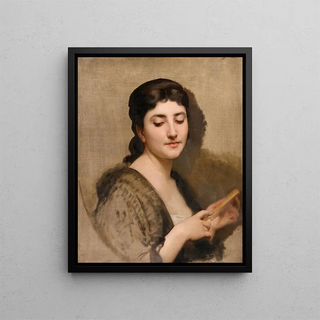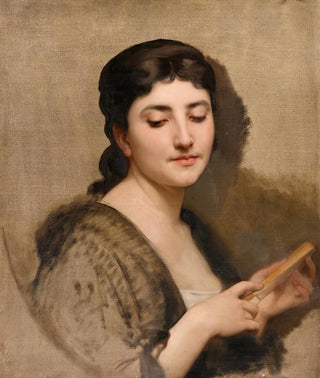Art print | A young woman with a fan - William Bouguereau


View from behind

Frame (optional)
William Bouguereau’s artwork, "A Young Woman with a Fan," transports viewers into a world filled with elegance and delicacy. Painted at the end of the 19th century, this canvas perfectly embodies the academic style of the French painter, renowned for his skill in capturing feminine beauty. The young woman, with her gentle face and delicate features, holds a fan that appears both as an accessory and a symbol of mystery. This piece, both intimate and universal, invites contemplation of the fleeting beauty of youth and the grace of feminine gestures, while evoking a world where art and nature intertwine harmoniously.
Style and uniqueness of the work
Bouguereau stands out for his striking realism and his ability to render light in an almost tangible way. In "A Young Woman with a Fan," every detail—from the reflections in the protagonist’s eyes to the folds of her dress—demonstrates remarkable meticulousness. The artist uses soft colors and delicate shades that create a serene atmosphere throughout the composition. The blurred background, almost impressionist, highlights the central figure and enhances her charm. The fan, a key element of the art print, adds subtle dynamism, suggesting both a game of hide and seek and an invitation to contemplation. Bouguereau thus succeeds in capturing a palpable emotion, freezing the moment in time.
The artist and his influence
William Bouguereau, born in 1825, is one of the most emblematic representatives of the French academic movement. His rigorous training at the École des beaux-arts in Paris and his travels in Italy shaped his artistic approach, pushing him to explore themes of beauty and femininity. Bouguereau established himself in the art world through works that combine technical virtuosity and sensitivity. His influence extends well beyond his era, inspiring many modern artists who see in him a master of realism. By celebrating beauty in all its forms, Bouguereau contributed to redefining the artistic standards of his time, making him a

Matte finish

View from behind

Frame (optional)
William Bouguereau’s artwork, "A Young Woman with a Fan," transports viewers into a world filled with elegance and delicacy. Painted at the end of the 19th century, this canvas perfectly embodies the academic style of the French painter, renowned for his skill in capturing feminine beauty. The young woman, with her gentle face and delicate features, holds a fan that appears both as an accessory and a symbol of mystery. This piece, both intimate and universal, invites contemplation of the fleeting beauty of youth and the grace of feminine gestures, while evoking a world where art and nature intertwine harmoniously.
Style and uniqueness of the work
Bouguereau stands out for his striking realism and his ability to render light in an almost tangible way. In "A Young Woman with a Fan," every detail—from the reflections in the protagonist’s eyes to the folds of her dress—demonstrates remarkable meticulousness. The artist uses soft colors and delicate shades that create a serene atmosphere throughout the composition. The blurred background, almost impressionist, highlights the central figure and enhances her charm. The fan, a key element of the art print, adds subtle dynamism, suggesting both a game of hide and seek and an invitation to contemplation. Bouguereau thus succeeds in capturing a palpable emotion, freezing the moment in time.
The artist and his influence
William Bouguereau, born in 1825, is one of the most emblematic representatives of the French academic movement. His rigorous training at the École des beaux-arts in Paris and his travels in Italy shaped his artistic approach, pushing him to explore themes of beauty and femininity. Bouguereau established himself in the art world through works that combine technical virtuosity and sensitivity. His influence extends well beyond his era, inspiring many modern artists who see in him a master of realism. By celebrating beauty in all its forms, Bouguereau contributed to redefining the artistic standards of his time, making him a






